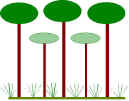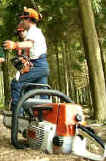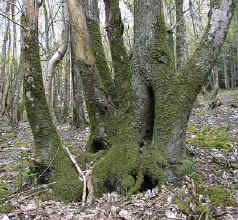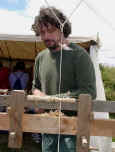An Introduction to British
Woodlands and their Management
Summary 
Woodlands in Britain range from native Oak and Ash woodlands, to coniferous forests consisting mainly of introduced species planted for timber production. There are many different kinds of woodland with varying structure, age and biodiversity. They can be managed to promote commercial timber production, game, conservation and recreation, or any combination of these. The emphasis in any individual wood will depend on the priorities of the current manager. A woodland may experience many changes and many different managers over its lifetime.
| Woodlands are habitats where trees
are the dominant plant form. The individual tree canopies often overlap and
interlink to form a more or less continuous canopy, shading the ground to varying degrees. However, woods are not just trees! They usually also contain a great variety of other plants depending on the amount of light available under the tree canopy. Look closely within a woodland and you will find that it is seething with enormous biodiversity (variety of life). The species present are all interacting in relationships which are often staggeringly complex.
|
There are many different types of woodland.
Within these broad categories there are many different kinds of woodland, depending on the dominant tree species making up the wood. Woodlands also vary depending on how long they have been established. In Britain, 'Ancient' woodlands are designated as those which have been continuously wooded since at least 1600 AD. Ancient woodlands may contain substantially different species and greater biodiversity than newer woods. This is because old trees tend to have greater biodiversity value than young ones. Continuity of wooded cover also favours species which are slow to colonize, or poorly dispersed. The presence of certain species can indicate ancient woodland
status.
|
The plant species in a woodland tend to
grow at various different heights within the wood. This will depend on their growth form
(tree, shrub or herb) and degree of tolerance to shading.
This often leads to the development of several distinct layers of vegetation within a wood. The dominant trees form the tallest layer. Under this, there may be shorter, shade tolerant trees and shrubs making up an understorey layer. Where herbs and grasses grow, they form a field layer. There may also be a ground layer of plants such as mosses and lichens. Trees in a wood provide food and microhabitats for a variety of different invertebrates. The other plants are no less important. The caterpillars of many of the woodland butterflies feed on the grasses and herbs on the woodland floor rather than on the trees themselves. If there is insufficient light for this field layer to develop, the butterflies will be eliminated. A wide range of plants within a woodland will provide a seasonal variety of flowers, fruits and seeds to feed animals such as insects and mammals. |
||||||||||||
Woodlands are actively managed for a number of reasons. These include maximizing the yield of economically important products such as timber and game, as well as for conservation and biodiversity. Recreational access is also becoming increasingly important. A woodland may be managed for one or more of these reasons. Where woodlands are multipurpose, conflicting management options can often arise. |
Coniferous woods will almost always have
been planted for timber production. This is because conifers grow much faster than
broadleaf trees and can yield crops of timber up to six times faster. Most are made up of
non-native species introduced to improve yields. Coniferous woodlands have wildlife value as well as timber value. In general however, their biodiversity will be less than that of broadleaf woodlands such as Oak. This is because coniferous woods are mostly composed of non-native tree species and are usually being managed to maximise timber production. However, the species making up the biodiversity of a coniferous forest are often different to those of a broadleaf forest.
|
Managing Woodlands for Biodiversity Animal diversity is to a great degree controlled by plant diversity. This is because the plants generally provide the architecture and structure of a habitat, as well as being the basis of food chains. Plant diversity in woodlands can be encouraged by making sure there are a variety of light levels within a woodland from deep shade to open glades. Planting a variety of native trees will also enhance animal diversity because native trees support many more invertebrate species. Different plants also provide structural diversity, offering multitudes of different microhabitats for other organisms.
|
||||||||||||
Traditional Woodland Management Native woodlands in Britain were traditionally managed to provide a continuous source of wood for firewood and structural materials, such as those used for hurdle making. This was done by coppicing trees within a woodland in rotation. Coppicing makes use of the natural self-regenerating power of trees. The tree is cut close to ground level for its timber, with the remaining base (stool) left to regenerate naturally. Regeneration takes the form of multiple shoots, so that coppiced trees have a distinct growth form with several similar sized trunks.
|
Where animals such as deer have access to a woodland, they may eat the regenerating shoots. To prevent this, trees may be pollarded instead of coppiced - that is cut off at between 2 - 5m above the ground, leaving a permanent trunk or 'bolling'. This sprouts in the same way as a coppiced 'stool' but out of reach of grazing animals. Traditionally, only a few of the trees would be cut at any one time. Cutting would be rotated through the wood. As a result, there would always be variation in tree age, from mature, through various stages of regeneration. This rotational cutting had the effect of letting light into the wood. It also created glades where a diversity of plants could flourish. Along with the diversity of plants also came a great diversity of associated animals. Traditionally managed woods are therefore good places to find high biodiversity.
|
Do you have a woodland to manage or would like to plant one?
|
||||||||||||
Continue to 'What is a Woodland?'






